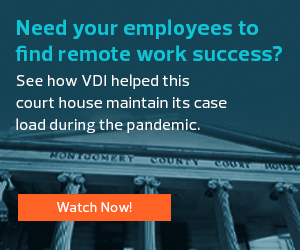Prior to the spring of 2020, the state of North Dakota was a lot like most governments when it came to its experience with remote workers. Usually, its offices were open — most agency employees never worked from home.
“We’d get a snow day once in a while,” recalls North Dakota CTO Duane Schell, “but even then, most things just shut down. It wasn’t like everyone suddenly had to telework.”
For those who did, the team in the state’s IT division had grown to rely on VMware Horizon, a virtual desktop infrastructure solution that gives employees easy and secure access to everything they’d have on their computers at work, Schell says. “Mostly, we used it to virtualize applications that were sensitive to network performance,” he explains. That included programs used by North Dakota’s geographic information systems team, for example. It also included the computer-aided design applications the state’s engineers needed to do their jobs.
“For anybody moving a lot of data and requiring a lot of bandwidth, the broadband at home isn’t good enough,” Schell says. “In those use cases, a virtual desktop environment is paramount. You need it if you’re going to operate with normal performance.”
At the onset of the pandemic, as Schell and his team prepared to move thousands of state workers offsite, they considered the success they’d had with VDI so far and decided they’d simply scale the technology up.
“We were fortunate that we had it as a tool in our toolkit,” he says. In the end, it took his team just 48 hours to enable 90 percent of the North Dakota state government workforce to work from home. In all, the push included more than 7,000 workers who had to empty out of more than 70 different agencies.
“Looking back and considering the circumstances, it went pretty smoothly. We hit a few roadblocks like everyone else, but we rolled everything out and we got the job done,” Schell says.
Agencies Rely Upon VDI as a Proven Solution for Remote Work
As agency IT leaders everywhere can attest, scaling existing infrastructure to accommodate remote workers is among the biggest challenges they’ve faced during the coronavirus pandemic. For some, however, VDI has come to the rescue — a technological answer to a potential human resources nightmare.
In Canada, for example, the IT team at Hastings Prince Edward Public Health — an agency offering services to citizens in Eastern Ontario — was able to easily move hundreds of staffers out of their offices thanks to a Nutanix VDI solution the organization already had in place. In Davenport, Iowa, where Cory Smith is CIO and CTO, the city gives credit to its own VDI platform for its successful pivot to telework in the face of the pandemic. “When we had to deal with a mass exodus of employees working from home,” Smith told GCN last June, “for us, it was pretty easy.”
That comes as no surprise to Zeus Kerravala, founder and principal analyst for ZK Research. Calling VDI “a tried-and-true technology,” Kerravala says it’s especially attractive to state and local agencies because it essentially allows all work to continue as if employees were onsite.
“It’s just really straightforward — there’s no training involved. No matter where I’m working, if I have my computer, I have access to an exact replica of my office desktop.”
This access is made possible in one of two ways, Kerravala says. With traditional VDI technology, software is loaded to a server in an on-premises data center and end-user computers are pointed to it. The second approach, Desktop as a Service, also involves delivering desktops through the cloud, but the infrastructure is managed off-premises by a third-party service provider.
Either method comes with big benefits to process-driven government agencies in particular, Kerravala says. Concerns around software licensing and data security and compliance are ameliorated because applications are kept under agency control, while the standardization that VDI offers makes things more manageable for workers. “For a lot of these employees, their jobs are very task oriented. It’s just easier to do your work when everything looks familiar.”
Amid Changing Routines, VDI Simplifies a Common Office Environment
Creating a remote work environment that would work easily for employees was a top priority for the North Dakota IT team as it ramped up its VDI solution, Schell says. “When you’re introducing this amount of change, it’s important to do everything you can to keep it simple,” he notes. “Our workers are under enough pressure trying to do their jobs in the middle of a pandemic. We just wanted to ensure we made things as seamless as possible.”
Remote employees of the state of North Dakota can now use their devices to log in to government systems through the state’s VPN, or they can open individual applications by clicking on the appropriate icons on their desktops. Schell and his colleagues rely on next-generation endpoint protection to bolster the organization’s security posture, and multifactor authentication is required as part of the VDI access process.
As the pace of the pandemic has slowed in recent months, many North Dakota state employees have returned to their offices, Schell says. Many others remain remote, however, and he doubts the state’s workforce will ever look like it did before the arrival of COVID-19 last year.
“I think the world has shifted and changed,” Schell says. “People have realized there are a number of different circumstances where telework actually makes a lot of sense.”
Many remote workers express high satisfaction with their arrangements, Schell notes, and there are plenty of reports showing that telework can lead to improvements in employee productivity. The good news, he says, is that organizations now have the technologies they need to make telecommuting feasible. “I think our experience with COVID-19 has shown that it can be done.”
MORE FROM STATETECH: Find out how VDI helps Montgomery County, Pa., child services workers help their community.













